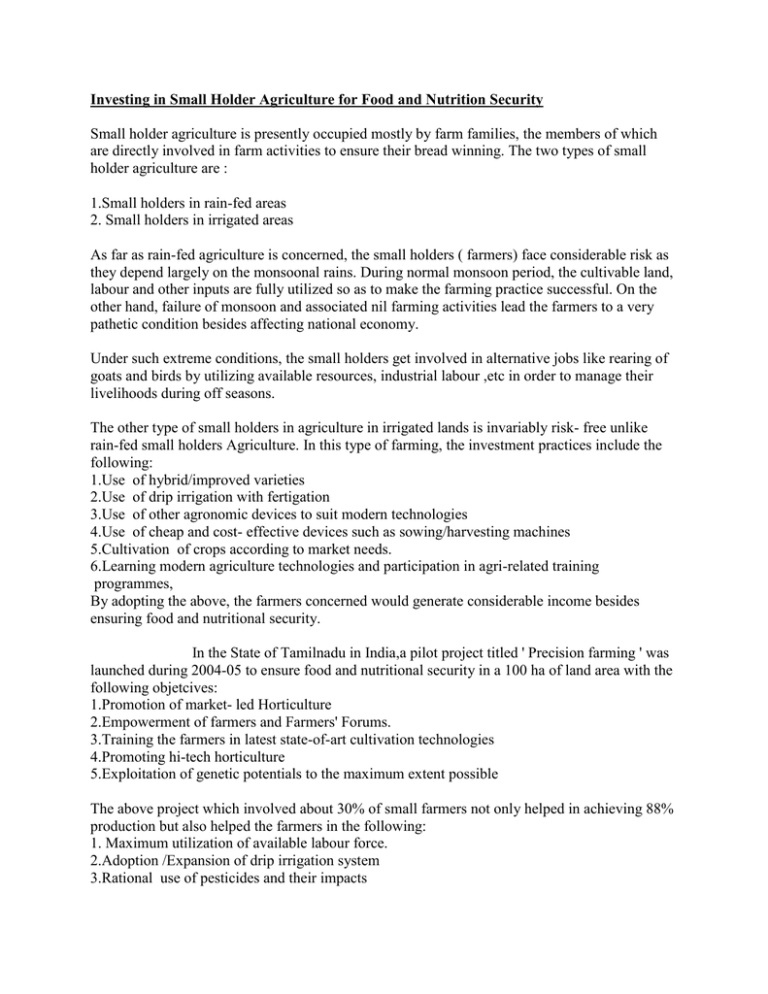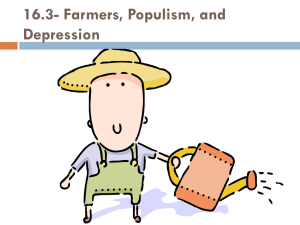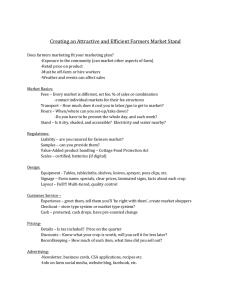Investing in Small Holder Agriculture for Food and Nutrition Security
advertisement

Investing in Small Holder Agriculture for Food and Nutrition Security Small holder agriculture is presently occupied mostly by farm families, the members of which are directly involved in farm activities to ensure their bread winning. The two types of small holder agriculture are : 1.Small holders in rain-fed areas 2. Small holders in irrigated areas As far as rain-fed agriculture is concerned, the small holders ( farmers) face considerable risk as they depend largely on the monsoonal rains. During normal monsoon period, the cultivable land, labour and other inputs are fully utilized so as to make the farming practice successful. On the other hand, failure of monsoon and associated nil farming activities lead the farmers to a very pathetic condition besides affecting national economy. Under such extreme conditions, the small holders get involved in alternative jobs like rearing of goats and birds by utilizing available resources, industrial labour ,etc in order to manage their livelihoods during off seasons. The other type of small holders in agriculture in irrigated lands is invariably risk- free unlike rain-fed small holders Agriculture. In this type of farming, the investment practices include the following: 1.Use of hybrid/improved varieties 2.Use of drip irrigation with fertigation 3.Use of other agronomic devices to suit modern technologies 4.Use of cheap and cost- effective devices such as sowing/harvesting machines 5.Cultivation of crops according to market needs. 6.Learning modern agriculture technologies and participation in agri-related training programmes, By adopting the above, the farmers concerned would generate considerable income besides ensuring food and nutritional security. In the State of Tamilnadu in India,a pilot project titled ' Precision farming ' was launched during 2004-05 to ensure food and nutritional security in a 100 ha of land area with the following objetcives: 1.Promotion of market- led Horticulture 2.Empowerment of farmers and Farmers' Forums. 3.Training the farmers in latest state-of-art cultivation technologies 4.Promoting hi-tech horticulture 5.Exploitation of genetic potentials to the maximum extent possible The above project which involved about 30% of small farmers not only helped in achieving 88% production but also helped the farmers in the following: 1. Maximum utilization of available labour force. 2.Adoption /Expansion of drip irrigation system 3.Rational use of pesticides and their impacts 4.Market -led crop production & Marketing experience 5..Resolving farmers indebtedness 6.Improvement in life style and socio-economic status 7..Formation of Farmers 'Associations Strategies to invest in small holder agriculture for food and nutritional security 1.Maximisation of the use of available water with Micro irrigation techniques 2.Identification and use of improved varieties/hybrids suitable to regions 3.Cluster approach-to face the marketing problems and efficient utilization of available resources. 4.Establishment of green house, shade net etc. to ensure maximum production per unit area. PRODUCTION ECONOMICS OF ONE HECTARE OF TOMATO HYBRID CULTIVATION. SL.NO 1 2 3 4 5 6 7 8 9 10 11 DETAILS OF EXPENDITURE COST OF SEEDS COST OF NURSERY PREP. AND SOWING COST OF PLOUGHING AND LAND PREPARATION PLANTING PLANT PROTECTION STAKING WATER SOLUBLE FERTILIZERS ORGANIC MANNURING IRRIGATION HARVESTING MAINTANANCE AND ETC. TOTAL EXPENDITURE COST IN RUPEES 1200.00 4000.00 4900.00 1500.00 13000.00 6000.00 7500.00 7500.00 8000.00 8000.00 4400.00 66000,00 Yield obtained 63 tonnes/HA Gross income of 3.90 Lakhs /HA Expenditure cost 0.66 lakhs/HA Net profit 3.24 lakhs./HA. CONCLUSION The concept of” Investment in small holder Agriculture” sector would gain momentum in the years to come owing to its large scale benefits to National economy in general and small Farmers in particular. Developing countries like India need to pay greater attention to this aspect in order to safeguard the small Farmers from vagaries of monsoon and associated livelihood problems.




